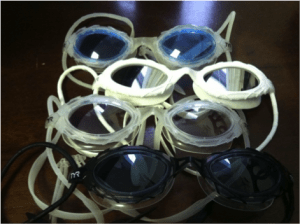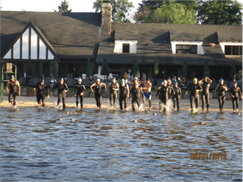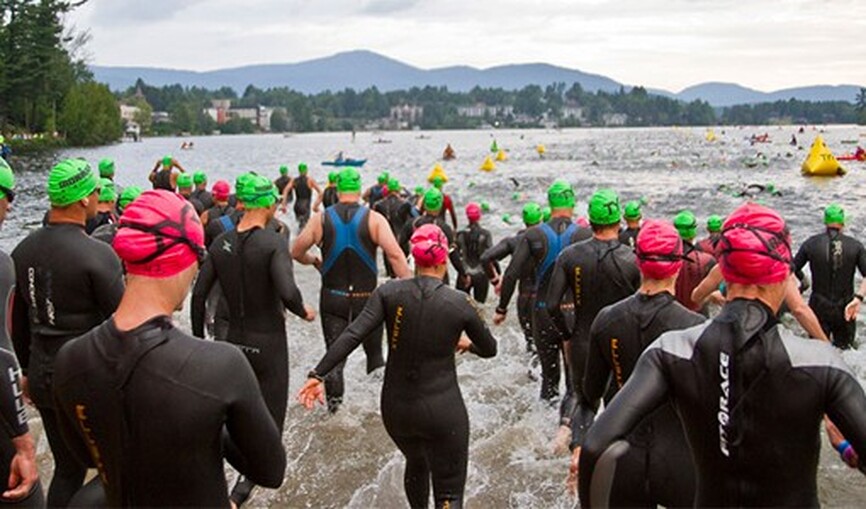|
3… 2… 1… BANG! The gun goes off and your race begins. Your adrenalin soars. It’s time to swim! You know how to swim, but this time it’s a little different. There’s other athletes all around you, no black line to follow and you can’t put your feet down. Open water swimming – especially on race day, can cause a lot of athletes stress and anxiety. However, with a little practice and a few tips and tricks you can boost your confidence and shave minutes off your open water swim. 1. Practice, practice, practice The more open water swim experience you can get before race day, the better. Inevitably, the more you practice swimming in the open water the more confident and comfortable you will become. Remember, frequency is key. It sounds simple and it is. Practicing is the BEST thing you can do. If you’re fortunate enough to have easy access to an open body of water on a regular basis, then make sure you take advantage this. Otherwise, be on the lookout for local open water swim clinics. You can also round up a few training buddies and take a field trip to the closest swimmable body of water (ocean, lake, river, pond, ect) and practice. Finally, this should be obvious, but in case it’s not – NEVER swim alone. 2. Get a Wetsuit! If you don’t have a wetsuit, you should invest in one. Not only will it keep you warm, but more importantly it will provide buoyancy, helping to keep you on top of the water and making it easier to swim. Triathlon wetsuits generally come in two styles. “Full” and “Sleeveless.” “Full” wetsuits (WITH sleeves) are a little bit more expensive, but they are the most buoyant option. Needless to say, it will also keep you warmer. When a professional triathlete is allowed to wear a wetsuit in a race, more times than not, she will go with a full wetsuit. “Sleeveless” wetsuits are another option. Life-long swimmers may choose to go this route because they don’t really need the extra bouncy and prefer not to have their arms & shoulders restricted. It also provides the athlete with a more “natural” feel in the water. Bottom line: Any wetsuit is better than nothing. And at the end of the day, if you are a beginner and have to choose between one or the other, I’d recommend going with a full wetsuit. NOTE: Once you get a wetsuit it’s a good idea to swim in it at least a few times before race day to make sure it fits properly and you are comfortable in it. 3. Goggle Selection  Goggles come in in all shapes and sizes. They also come in a variety of colors. When it comes to swimming outside, making the proper goggle selection will make a big difference. Selection is determined based upon the weather conditions. For example, on a cloudy or rainy day, you may choose to wear goggles with clear, light blue or yellow lenses. These options will help brighten up your surroundings and make it easier to see. On the contrary, if it’s a bright and sunny day or if you’re swimming in the morning and the sun may rise while you’re in the water, “mirrored” or “smoke” lenses are your best bet. It is also wise to bring a second pair of goggles to each race you attend (or anytime you swim). This way you can have a clear AND mirrored set of goggles to choose from depending what the weather is like. Additionally, if the band snaps while you’re warming up or if your neighbor in transition steps on your goggles you will have a back up pair. 4. Warm up (10-15 minutes) You warm up before all of your workouts (at least you should), so race day should be no different. It is a good idea to get in the water (if permitted) prior to your wave going off to warm up. Give yourself 10-15 minutes to get warm. Not only will this help get your blood flowing and prepare your body to swim; it will also give you a chance to become comfortable in the water at your leisure. Walk in slowing, wade a bit, get a feel for the temperature and take a peak to see what the visibility is like under the water. This will all help give you reassurance and make you feel more confident once the gun goes off. 5. Position yourself appropriately  If you’re a strong swimmer, position yourself front and center. If swimming is not your strong suit, then seed yourself towards the back and off to the side. Once the gun goes off, take your time getting in and swim towards clear water. There is no reason to battle the chaos. It’s ok to swim 10-15 yards off to the side of the buoys. Don’t worry about losing a few seconds because the more comfortable you feel the better your swim will go anyway. Finally, if you are a slower swimmer you can probably expect the faster athletes from the wave behind you to eventually catch up. If you’re swimming towards the outside you may not even see them, but either way stronger swimmers will see you and swim around you. Just swim in your own little bubble and continue swimming one stroke at a time. 6. Start out SLOW When the gun goes off and adrenalin is pumping, a lot of athletes tend to take off and start swimming way too fast for their ability. Often people don’t realize this until about 200 yards in when their heart rate is through the roof and they’re gasping for air. So, instead of starting off like a madman and struggling to finish, try starting out much slower than race pace and gradually increase your speed as you start to get into a rhythm. This way, you’ll finish strong and have a better experience. 7. Cornering Buoys When it comes time to corner a buoy, do yourself a favor and take a wide turn. This will allow you to avoid all the pushing and shoving going on right text to the turn buoy. Again, don’t worry about the small bit of extra swimming you’ll do by taking a wider turn. The energy you’ll save by swimming uninterrupted will keep you feeling good and confident. Also, it ok to breast stroke around the buoy, but if you don’t have to, it’s better to just keep your head down and continue swimming. Regardless of how you decide to get around the buoy, be aware of other athletes who may be breast stroking ahead of you. Due to the nature of the stroke and the way you kick, if you’re not paying attention someone’s leg/foot could whack you in the face. 8. Pause, float on your back, breast stroke Finally, it’s not uncommon for newer triathletes to get some anxiety or even freak out while swimming in the open water. If this happens, it’s ok. The best thing to do is pause from swimming and collect yourself for a moment. Roll onto your back and float for as long as you have to and try to relax. This will help get your heart rate under control and calm you down. Once you’re ready to start moving again, start by breast stroking. Then when you’re ready, put your head down and resume swimming.
Comments are closed.
|
Categories
All
Archives
July 2024
|
RTA TriathlonRTA is a comprehensive triathlon coaching organization and fully supported USAT sanctioned triathlon club.
We are based in Ridgewood, NJ and coach triathletes of all abilities from across the country. Our mission is to make you a better triathlete. Contact us when you're ready to take your "game" to the next level. |
|
|
Quick Links |
Let's get social
RTA Triathlon
Copyright © 2022
Copyright © 2022


 RSS Feed
RSS Feed
